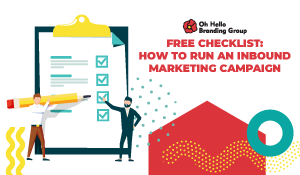Oh, Hello Branding Group
What Is Inbound Marketing?
According to HubSpot, it is a "business methodology that attracts customers by creating valuable content and experiences tailored to them. While outbound marketing interrupts your audience with content they don’t always want, inbound marketing forms connections they are looking for and solves problems they already have". Some examples of inbound marketing are blogposts, social media campaigns, ebooks, and webinars.
What Is The Hype Around Inbound?
Weidert Group found that in the United States, 76% of marketers use inbound marketing as their primary strategy. They also found that "inbound marketing campaigns achieve higher ROI than outbound techniques regardless of company size, geography or budget". Because of these statistics, inbound marketing has a reputation for being more effective than other types of marketing. So why is inbound marketing so much more effective?
Inbound marketing drives users to your site, social media pages, and blog, etc. By creating valuable content that directly appeals to your target demographic, they will want to go to your website.
For example, let's say you own a beauty company and have a new lip gloss coming out. If you choose to do inbound marketing, you could create a blogpost around the new product, such as "10 Glossiest Lip Glosses of 2020". You would include lip glosses from other brands as well, so it's not just an ad for your new product. Then, a customer who is in need of a new lip gloss will probably do a Google search when they are ready to purchase, and hopefully, they'll see your blogpost. The customer is glad they saw your post and even if they don't buy your lipgloss, your brand is now in their head for consideration next time they need a lipgloss. Now let's say you chose to do outbound marketing for this same product. You decide to run Instagram and Facebook ads promoting your new lipgloss. These ads are directly interrupting the customer's regular content, and they may be interested, or they may be very turned off by your ad.
The bottom line is that inbound marketing establishes a good relationship with prospects, because you are giving them valuable content rather than just constantly running ads.
Are The Rumors True, Is It Actually More Effective?
Yes, think of it this way. According to Statista, "In 2019, roughly 25.8 percent of internet users were blocking advertising on their connected devices". Statista also found that, "In 2019, an estimated 2.95 billion people were using social media worldwide, a number projected to increase to almost 3.43 billion in 2023". Consumers are becoming more and more adverse to advertisements, but companies can get the same message out in different ways. While ad block use is increasing, social media and content consumption is increasing. People would much rather see a product in content they're already seeking out, than have that product presented in an advertisement.
Here's another example:
Influencers have become exponentially popular in the last few years, and many people have their own favorites. However, most people would respond more favorably to an unsponsored "10 Lip Glosses I Couldn't Live Without" video by a YouTuber than a disclosed advertisement during a video for a lipgloss.
The key to inbound marketing is providing valuable content, so prospects will seek you out (because they know how good your products and content are!)
Create your own inbound marketing campaign today, with our Free Checklist.

Click the button below to download!






Submit a Comment